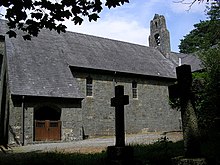St Mark's Church, Brithdir
| St Mark's Church, Brithdir | |
|---|---|

St Mark's Church, Brithdir, from the south
|
|
| Coordinates: 52°44′55″N 3°50′00″W / 52.7487°N 3.8332°W | |
| OS grid reference | SH 764 184 |
| Location | Brithdir, Gwynedd |
| Country | Wales |
| Denomination | Church in Wales |
| Website | Friends of Friendless Churches |
| History | |
| Founder(s) | Mrs Louisa Tooth |
| Dedication | Saint Mark |
| Consecrated | 26 April 1898 |
| Architecture | |
| Functional status | Redundant |
| Heritage designation | Grade I |
| Designated | 26 May 1995 |
| Architect(s) | Henry Wilson |
| Architectural type | Church |
| Style | Arts and Crafts |
| Groundbreaking | 1895 |
| Completed | 1898 |
| Specifications | |
| Materials | Local grey-green ashlar stone, slate roofs |
St Mark's Church, Brithdir, is a redundant church in the hamlet of Brithdir, Gwynedd, Wales. It is designated by Cadw as a Grade I listed building, and is under the care of the Friends of Friendless Churches. It is considered to be one of the finest Arts and Crafts churches in Wales.
The building of the church started in 1895; it was completed in 1898 and was consecrated on 26 April. The church was designed by Henry Wilson who was a "leading figure of the Arts and Crafts Movement". It was commissioned by Mrs Louisa Tooth in memory of her second husband Charles Tooth, who had been chaplain and founder of the Anglican St Mark's English Church, Florence and a brother of Arthur Tooth. Since being declared redundant, it has been in the care of the Friends of Friendless Churches.
The church is constructed in brick, and faced with local grey-green ashlar stone; it has slate roofs. The "external stonework was intended to be left 'untooled' (rough)", because the architect "wished the church to appear as if it had sprung out of the soil, instead of being planted down on it". Its plan consists of a nave with north and south porches, and a chancel with north and south transepts. In the west end are two tiers of ogee-headed windows. Between the windows in the upper tier is a cross in relief. There are similar windows, asymmetrically placed, on the north and south sides of the church. On the roof, in a position to the west of the transepts, is a two-tier bellcote. In its lower tier is a round-headed arch containing the bell, with a smaller round-arched opening above. At the east end is a stepped buttress containing a round-arched lancet window, on each side of which is an ogee-headed window.
...
Wikipedia

